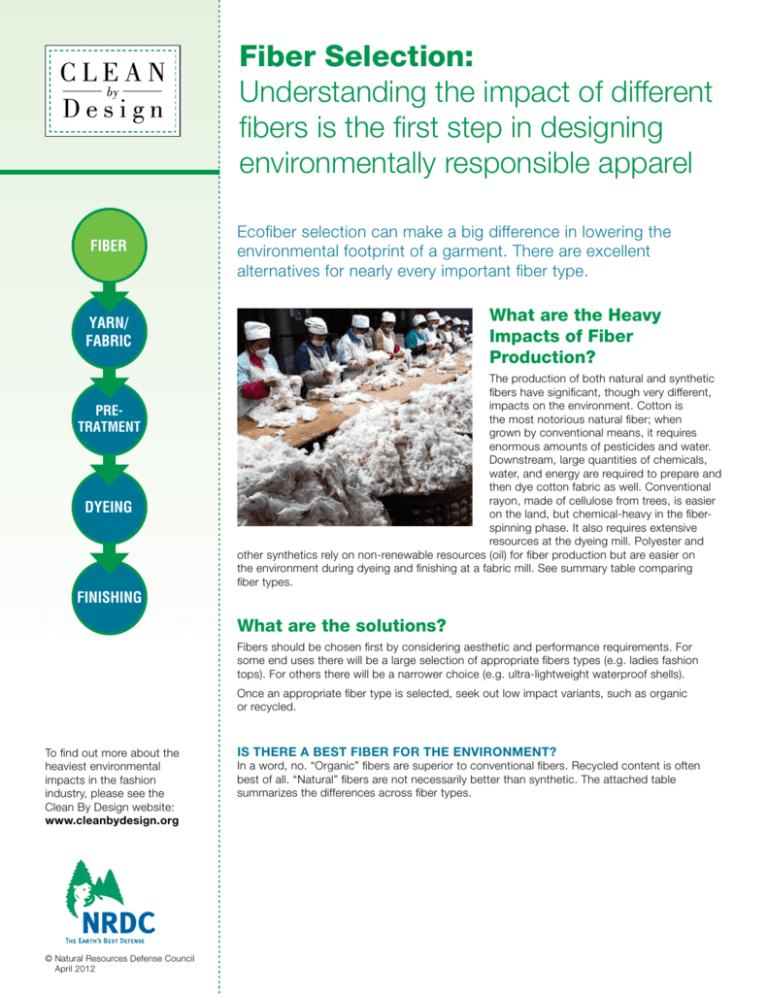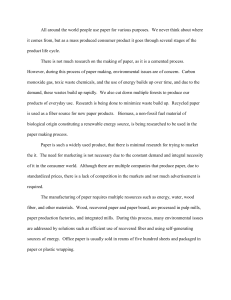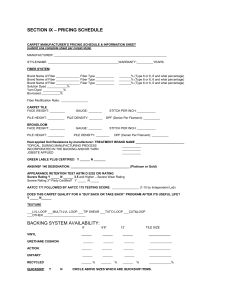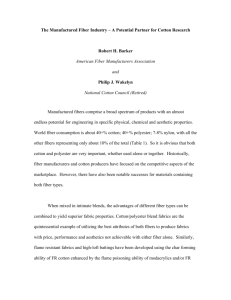NRDC Fiber Selection - Natural Resources Defense Council
advertisement

Fiber Selection: Understanding the impact of different fibers is the first step in designing environmentally responsible apparel FIBER Ecofiber selection can make a big difference in lowering the environmental footprint of a garment. There are excellent alternatives for nearly every important fiber type. What are the Heavy Impacts of Fiber Production? yarn/ Fabric pretratment DYEING finishing The production of both natural and synthetic fibers have significant, though very different, impacts on the environment. Cotton is the most notorious natural fiber; when grown by conventional means, it requires enormous amounts of pesticides and water. Downstream, large quantities of chemicals, water, and energy are required to prepare and then dye cotton fabric as well. Conventional rayon, made of cellulose from trees, is easier on the land, but chemical-heavy in the fiberspinning phase. It also requires extensive resources at the dyeing mill. Polyester and other synthetics rely on non-renewable resources (oil) for fiber production but are easier on the environment during dyeing and finishing at a fabric mill. See summary table comparing fiber types. What are the solutions? Fibers should be chosen first by considering aesthetic and performance requirements. For some end uses there will be a large selection of appropriate fibers types (e.g. ladies fashion tops). For others there will be a narrower choice (e.g. ultra-lightweight waterproof shells). Once an appropriate fiber type is selected, seek out low impact variants, such as organic or recycled. To find out more about the heaviest environmental impacts in the fashion industry, please see the Clean By Design website: www.cleanbydesign.org ©N atural Resources Defense Council April 2012 Is there a Best Fiber for the Environment? In a word, no. “Organic” fibers are superior to conventional fibers. Recycled content is often best of all. “Natural” fibers are not necessarily better than synthetic. The attached table summarizes the differences across fiber types. Quality: Are Eco-fibers as good as conventional fibers from a technical perspective? Yes, mostly. Organic and BCI cotton are identical to conventional cotton in terms of quality and performance. Recycled cotton fabrics are generally a bit weaker and a bit hairier than virgin fiber equivalents. Organic linen and hemp are indistinguishable from conventional counterparts. Recycled wool fabrics are not as strong or smooth as virgin wool fabrics, but for many end uses they are certainly fit for purpose. On the synthetic fiber front, you have to be a real expert to notice the difference between virgin and recycled polyester. Be wary of replacing established fibers with completely different fiber type that is unsuited for a particular end use. The eco-credentials of Tencel are well known, for example, but you wouldn’t want to make sports socks out of it as its wet abrasion resistance is not good. The big picture: Eco-fiber section can make a big difference in lowering the environmental footprint of a garment or collection. However, fibers must be woven/knitted, dyed, and finished before they become fabric. All of these processes have negative environmental impact, and the size of the total production impacts is determined by the efficiency of the factories that dye and finish fabrics, as well as the fiber type. For example, although organic cotton is a natural fiber, the impacts of dyeing it are higher than the impacts of dyeing polyester. Fast fashion has a negative impact: Replacing clothing that wears out or goes quickly out of style has a big environmental impact; timeless fashion for staples in our wardrobe and production of durable apparel can play an important role in reducing environmental footprint. “Timeless fashion” makes a lot of eco-sense. NRDC recommends: n etermine aesthetic, quality and performance requirements to choose an appropriate fiber D type first—then select the lowest impact variant of that fiber. n on’t forget that fibers have to be spun, knit/woven, dyed, finished, made into garments, D and transported. Although fiber choice is important, it is only part of a bigger picture. n Don’t bother to shoehorn low impact eco-fibers into short-lived, fast fashion garments. Environmental Comparison of Fiber Types Land impact Use of nonrenewable resources Cotton Organic Cotton Viscose Rayon Tencel Polyester Recycled polyester Wool Cashmere Alpaca Nylon Uses prime arable land. Significant pollution from fertilizer and pesticide Uses prime arable land Trees grow on marginal land with higher cellulose yields than cotton Trees grown on marginal land with higher cellulose yields than cotton None None Sheep normally graze on marginal land and cause little damage Goats can cause significant land damage Alpaca graze on marginal land and cause little damage None Made from oil Made from bottles that were originally made from oil Very little used­—a bit of sheep dip for ticks Very little Very little Made from oil Used for fertilizers and pesticides Very little used Some brands use certified wood Wood is certified Significant chemical use in wood pulp manufacture Significant chemical use in wood pulp manufacture Significant solvent use in fibre manufacture Solvent used in fibre manufacture is recycled Water to grow/spin fiber Very high usage, although some crops are rain fed Very high usage, although some crops are rain fed Significant water used in wood pulp and fibre manufacture Significant water use in wood pulp manufacture Very low usage Very low usage Very low usage Very low usage Very low usage Very low usage Energy to grow/spin fiber Low requirement Low requirement High energy requirement in wood pulp and fibre manufacture Less energy in fibre manufacture than viscose Very high energy requirement Very high energy requirement Very low —some greenhouse gases from sheep Very low —some greenhouse gases from goat Very low energy requirement Very high energy requirement Dyeing and finishing impacts Very high use of water, energy and chemicals in typical processing Very high use of water, energy and chemicals in typical processing Significant, but less water, energy and chemicals use than for cotton Significant, but less water, energy and chemicals use than for cotton High temperature dyeing process but shorter process with less chemical use—overall lower impact than cotton High temperature dyeing process but shorter process with less chemical use—overall lower impact than cotton Intensive scouring process to remove lanolin plus chemically intensive process to achieve washability Similar to, but lower impact than wool Similar to but lower imapct than wool Similar to Polyester Other High pollution loading from dyeing High pollution loading from dyeing Two methods of recycling —one depolymerisation / repolymerisation and the other a lower impact, simple melting process that yields slightly inferior fibre Recycled wool of only slightly lower quality than virgin wool is available from Italian industry Alpaca are raised in less fragile terrain Recycled nylon is becoming available Untreated effluent causes major damage Much less pollution than from viscose factories but wood pulp the same Cashmere goats are raised in very fragile areas Untreated effluent causes major damage. Very significant pollution from some wood pulp and viscose factories Printed on recycled paper © Natural Resources Defense Council April 2012







